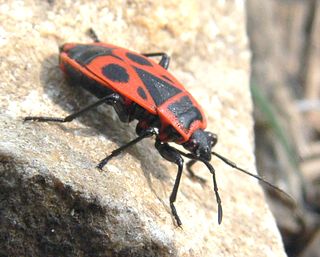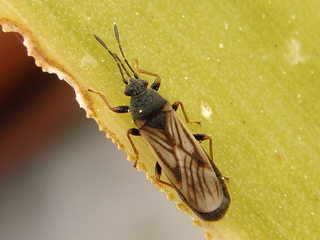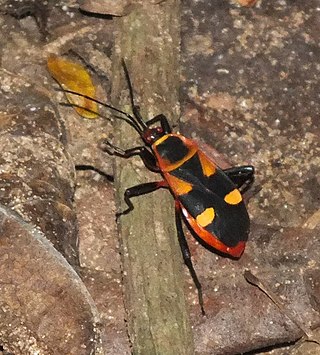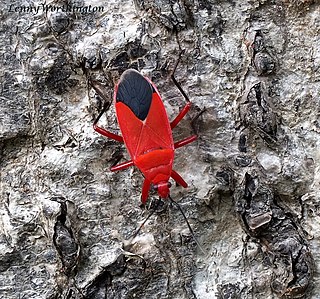
The boxelder bug, also called box bug, maple bug or, inaccurately, box beetle, is a species of true bug native to eastern North America. The western boxelder bug Boisea rubrolineata is a relative of this species and is native to western North America. Boxelder bugs are found primarily on boxelder trees, as well as on maple and ash trees.

The firebug, Pyrrhocoris apterus, is a common insect of the family Pyrrhocoridae. Easily recognizable due to its striking red and black coloration, it may be confused with the similarly coloured though unrelated Corizus hyoscyami. Pyrrhocoris apterus is distributed throughout the Palaearctic from the Atlantic coast of Europe to northwest China. It has also been reported from the United States, Central America, and India, and is also found in Australia. It has been reported as recently expanding its distribution northwards into mainland United Kingdom and eastward on to the coast of the Mediterranean Sea. They are frequently observed to form aggregations, especially as immature forms, containing from tens to perhaps a hundred individuals.

Pyrrhocoridae is a family of insects with more than 300 species world-wide. Many are red coloured and are known as red bugs and some species are called cotton stainers because their feeding activities leave an indelible yellow-brownish stain on cotton crops. A common species in parts of Europe is the firebug, and its genus name Pyrrhocoris and the family name are derived from the Greek roots for fire "pyrrho-" and bug "coris". Members of this family are often confused with, but can be quickly separated from, Lygaeidae by the lack of ocelli on the top of the head.
Coriobacterium is a genus of Actinomycetota, in the family Coriobacteriaceae. Coriobacterium are non-motile, Gram-positive, non-sporulating rods, which inhabit the gastrointestinal tract of firebugs. Up to now there is only one species of this genus known.

Jadera haematoloma, the red-shouldered bug, goldenrain-tree bug or soapberry bug is a species of true bug that lives throughout the United States and south to northern South America. It feeds on seeds within the soapberry plant family, Sapindaceae, and is known to rapidly adapt to feeding on particular hosts. The species is often confused with boxelder bugs and lovebugs.

Corizus hyoscyami is a species of scentless plant bug belonging to the family Rhopalidae, subfamily Rhopalinae. It is commonly called the cinnamon bug or black and red squash bug.
Hermann Paul August Otto Henking was a German cytologist who discovered the X chromosome in 1890 or 1891. The work was the result of a study in Leipzig of the testicles of the firebug, during which Henking noticed that one chromosome did not take part in meiosis. He named this the X element because its strange behaviour made him unsure whether it was genuinely a chromosome. It was later named the X chromosome after American cytologist Clarence Erwin McClung established that it was not only a genuine chromosome but a sex-determining one, though McClung incorrectly guessed that it was the male-determining sex chromosome.

European Journal of Entomology (EJE) is a quarterly peer-reviewed open access scientific journal published by the Czech Academy of Sciences. It covers research in entomology, including Myriapoda, Chelicerata, and terrestrial Crustacea. It was established in 1904 by the Czech Entomological Society under the title Acta Societatis Entomologicae Bohemiae, then later as Acta Entomologica Bohemoslovaca. The insect depicted on the cover of the journal is Pyrrhocoris apterus. According to the Journal Citation Reports, the journal has a 2011 impact factor of 1.061. In 2016, the journal became electronic-only and open access.

Himacerus apterus, known as the tree damsel bug, is a species of damsel bug belonging to the family Nabidae, subfamily Nabinae.

Ischnodemus sabuleti, also known as the European chinch bug, is a species of swarming true bug from the family Blissidae, which family also includes the American Chinch Bug Blissus leucopterus. It was first described by Carl Fredrik Fallén in 1826.

Roscius is an Afrotropical genus of true bugs in the family Pyrrhocoridae, the cotton stainers. They are often confused with bugs in the family Lygaeidae, such as the genus Oncopeltus, but can be distinguished by the lack of ocelli on the head.

Dysdercus is a widespread genus of true bugs in the family Pyrrhocoridae; a number of species attacking cotton bolls may be called "cotton stainers".

Antilochus is an Old World genus of true bugs in the family Pyrrhocoridae, erected by Carl Stål in 1863. Species in this genus occurs in tropical Africa including Madagascar, South and Southeast Asia, the Malay Archipelago, and New Guinea.

Antilochus coquebertii is an Old World species of true bug in the family Pyrrhocoridae, occurring in South and Southeast Asia. It is brightly coloured, red and black, and is a beneficial predator on other pyrrhocorids, especially the genus Dysdercus, which are crop pests. They are often confused with bugs in the family Lygaeidae, but can be distinguished by the lack of ocelli on the head, and they can be easily distinguished from Dysdercus by the lack of white stripes on the body. They are known to be cannibalistic in nature.

Xylocoris is a genus of bugs in the monotypic tribe Xylocorini of the family Anthocoridae. There are approximately 50 described species in Xylocoris worldwide. Nearly 30 species occur in the Palaearctic Region, 10 are known from the Nearctic Region, and 6 from the Oriental Region. They occur in various habitats, often found under plant litter and under tree bark where they feed on small arthropods. Certain species inhabit stored food facilities.

Anthocorini is a tribe of minute pirate bugs in the family Anthocoridae. There are more than 30 described species in Anthocorini.

Scantius aegyptius, the Mediterranean red bug, is a species of red bug in the family Pyrrhocoridae, that is a pest of plant species in the family Malvaceae.

Scantius is a genus of mostly African and European bugs in the family Pyrrhocoridae. There are at least two described species in Scantius.

Halticus is a genus of fleahoppers in the family Miridae. There are at least 20 described species in the genus Halticus.

Probergrothius sanguinolens is a species of bug found in India.
















